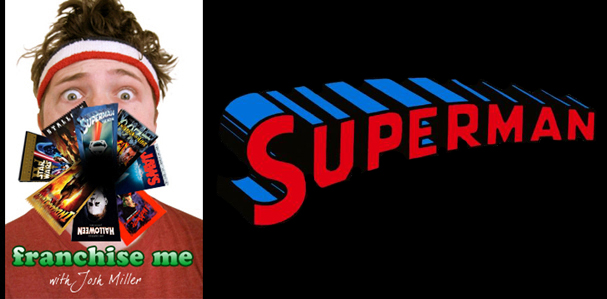
Hollywood loves a good franchise. The movie-going public does too. Horror, action, comedy, sci-fi, western, no genre is safe. And any film, no matter how seemingly stand-alone, conclusive, or inappropriate to sequel, could generate an expansive franchise. They are legion. We are surrounded. But a champion has risen from the rabble to defend us. Me. I have donned my sweats and taken up cinema’s gauntlet. Don’t try this at home. I am a professional.
Let’s be buddies on the Facebookz!
The Franchise: Superman: following the peacekeeping exploits of super-powered alien Kal-El, who was sent to Earth moments before his home-planet exploded, and was then subsequently raised by middle-American farmers under the name of Clark Kent. Created by writer Jerry Siegel and artist Joe Shuster as a comic book character, the franchise has expanded into pretty much every single conceivable medium, spanning from 1938 to the present. For our purposes here, we’ll only be examining the theatrically released live-action films.
previous installments
Superman (1948)
Atom Man vs Superman
Superman and the Mole Men
Superman (1978)
The Installment: Superman II (1980)
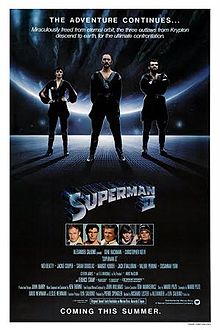
The Story:
So some terrorists are threatening to blow up the Eiffel Tower. Lois is there reporting on it. So of course Superman shows up to save her, meanwhile tossing the terrorist bomb into outer space where – wouldn’t you know it! – General Zod and his two cronies are floating by in their Phantom Zone prison-disc-thing. Kaboom! Now they’re free and looking for a planet to dominate. Meanwhile, Lex Luthor escapes from prison and finds the Fortress of Solitude. Further meanwhile, Lois figures out that Clark is Superman. Then they hump each other. Then Superman gives up his powers forever so he can be with Lois. Then he immediately regrets it when he realizes that Zod and Luthor are up to some shit, and Zod wants everyone to kneel before him. So Superman just goes and gets his powers back, even though he wasn’t supposed to be able to get them back. Then — super battle ensues!
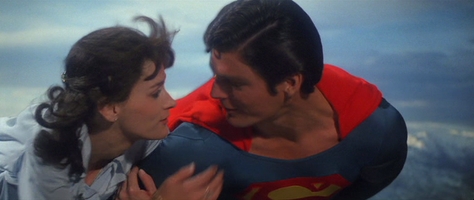
What Works:
The main selling point of Superman II is hard to miss — Terrence Stamp as General Zod. Last time we talked about the failings of Gene Hackman’s Lex Luthor. He was too goofy, too inconsequential. In a film that was otherwise earnest, sincere, and unafraid to be quaint, Hackman’s detached whimsy simply didn’t fit. Or at least it didn’t connect the same way Christopher Reeve did. Unless these films are your only encounter with Lex Luthor, I have a hard time believing Hackman’s Luthor is the Luthor you see in your head. Terrence Stamp’s Zod on the other hand is the kind of villainous character/performance that makes actors want to play villains. Zod commands your attention whenever he’s on screen. Superman I and II were originally planned to be even more connected, with the first film ending on a cliffhanger instead of Superman reversing time to save Lois. This actually makes the decision to fashion Luthor as a wacky nuisance make a lot more sense. It was all supposed to be building up to Zod. Even just on paper Zod is a great villain. Personality-wise he is the anti-Superman — cold, selfish, uncaring, megalomaniacal. He is also a connection to Superman’s past, and thus Superman, in a way, is forced to reject Krypton when he rejects Zod. Zod is obviously a dick, but nonetheless Superman is choosing Earth over his own kind. In reality, once you remove the epic fight scene and the scenes of Zod farting around the countryside with his two sidekicks, Zod doesn’t do that much in the film. It is Terrence Stamp that makes Zod memorable. That eerie, deliberate delivery — he feels alien. He makes Zod’s predilection for people kneeling before him carry an uncomfortable menace. The Kryptonian criminals – Zod, Ursa (Sarah Douglas) and Non (Jack O’Halloran) – steal the whole movie. Though it is a little silly, I love the scene in which they land on the moon and have an unfortunate encounter with some astronauts. (Unfortunate for the astronauts, that is.) Truth is, the Kryptonians are fairly silly all around, especially Non and his ongoing struggles to get his heat vision to work. And they alter Mt. Rushmore to feature their faces! That’s retarded! They prove that villains can be funny and still convey a sense of danger.
Also, the presence of some legit heavies allows Luthor to fit more capably into the film, where his cartoon-villainy (like requesting he be given Australia as payment for helping Zod) is welcome good clean fun when offset against Zod’s darker schemes. In other words, Luthor is now freed up to be the comic relief he always was. And it works. The opening prison break sequence presents Luthor and Otis as a latter-day Abbott and Costello — I particularly love watching chubby Ned Beatty sinking the hot air balloon being used in their escape as he tries to climb up its ladder. Good old-fashioned visual humor right there. In fact, Hackman and Beatty are so successfully funny here that I found myself missing Otis after Luthor and Ms. Teschmacher abandon him in prison.
One of the frequent trappings in any ongoing superhero story is the need for the hero to hide his identity from those close to him. Yes, yes, we know he’s trying to protect them, but as Smallville frustratingly demonstrated season after season, watching your hero repeatedly lie to and then guilt trip his friends for not believing his lies becomes problematic for his likability after a while. One of the many reasons Iron Man hit audiences with such an electric charge of excitement was the bold ending in which Tony Stark revealed to the whole world that he was a superhero. Superman is always the worst offender in this area, because Superman doesn’t wear a mask. So, really, anyone who doesn’t think Clark is Superman seems like kind of an idiot to audience members over the age of seven. I like that Superman II tackles this head-on, with Lois becoming convinced that Clark and Superman are the same person, and going to crazy lengths to prove it. This makes Lois smart. Having her jump into Niagara Falls (confident that Clark will have to reveal himself to save her) is a great bit, both calculating and ballsy. It says a lot about Lois. Then, it also makes Clark smart when he finds a way to save Lois without outing himself. And then once we got that fun gag out of the way, Clark does get outed anyway. Now we can explore what a true relationship between Lois and Clark/Superman will be. It turns out that relationship isn’t very interesting, and then Lois forgets everything at the end of the film, returning us to the status quo, but hey, I liked the forward momentum while it lasted.
As I just mentioned, Superman wasn’t originally supposed to end with Superman zooming around the Earth, traveling back in time. That was the end of Superman II. But the Salkinds were savvy enough to realize that ending the first film on a cliffhanger would seem like a huge let-down. Hardly anything happens during the climax of Superman. Superman doesn’t fight Luthor. He’s just flying around trying to stop missiles. Superman II doesn’t have that problem. Much of the FX work leaves something to be desired now, but the epic super-battle in downtown Metropolis between Superman and the Kryptonians is the sort of thing we want/need from the climax of a Superman film. Super beings punching each other through walls, into buses, etc. I particularly like the bit in which Superman and Non disappear beneath the pavement, and we can merely hear the sounds of their ensuing fisticuffs, before Non gets launched up out of the ground, up into the air, and completely through a skyscraper. The FX on that bit stand up excellently.
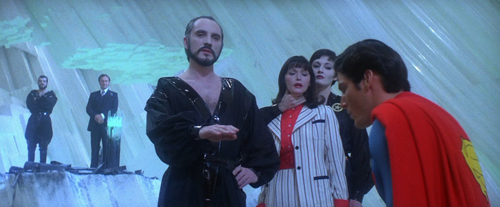
What Doesn’t Work:
Superman II has a pretty wonky back story for such a major release. For those unfamiliar with the tale, here’s the basic lowdown: Richard Donner had been tasked with the mammoth undertaking of shooting Superman and its sequel not back-to-back, but simultaneously. This he did. But as the release date for the first film approached, Donner was forced to focus on its completion, leaving the rest of II to wait until things slowed back down. The majority (nearly 75% by Donner’s own estimate) of the second film was in the can at this point. And though Donner’s and the Salkinds’ stories differ on precisely why, whatever the reason, before production could resume on Superman II Richard Donner was fired and replaced with Richard Lester, who had directed the Salkinds’ The Three Musketeers (1973) and The Four Musketeers (1974). Then, instead of completing the remaining 25% of the film, Lester and the Salkinds went back to the drawing board on much of the movie, doing extensive rewrites and reshoots. Possibly all this meddling was to correct some creative issues, but it is also hard to ignore the fact that due to DGA rules 50% of the film had to be Lester’s in order to give him credit, and even more than that if they wanted to drop Donner’s credit entirely. In the end Lester presented the world with a very different film from what had originally been planned. Fortunately for Richard Donner, he later made Lethal Weapon, cementing his status as a modern genre master and inspiring hungry fans to petition Warner Bros to release Donner’s version of Superman II. And the fans actually succeeded! Superman II: The Richard Donner Cut (2006) now exists for all to see, as a document to just how wildly off-book the Lester version went. The Donner Cut isn’t canon, so discussing it as its own installment is pointless. It is also pointless to lambast the theatrical cut for “changing” Donner’s vision. Changing something isn’t inherently bad. But it is also hard to resist contrasting the two films, especially when it helps highlight problems in Superman II.
None of the cast members were happy with Richard Donner leaving the project. I don’t know if it was specifically linked to Donner’s departure, or other issues with the Salkinds, but Gene Hackman never returned to complete his Luthor storyline. So a stunt double and an unconvincing sound-a-like were used to spackle things together. It isn’t Bela Lugosi in Plan 9 from Outer Space unmistakable — I’m sure the average audience member never noticed it wasn’t Hackman, but they likely often wondered, “Why does this part suck like this?” But whatever. If Hackman had died, I’d be commending the filmmakers for handling things so smoothly. The problem is that this sort of cheap-fix permeates the whole film. Superman is an expensive-looking film. Superman II is a much cheaper looking film. I don’t know the details, but it seems like these decisions were just penny-pinching or greed on the part of the Salkinds. In a normal scenario, I can understand why they wouldn’t want to pony up Marlon Brando’s crazy demands to appear in a sequel. BUT DONNER HAD ALREADY SHOT HIS SCENES! They just didn’t want to pay him what they had already agreed upon to use his footage in II. Here is where the Salkinds’ decisions start to affect the quality of the story and the discussion of Donner’s original film become relevant…
So no Jor-El. That would be fine if the filmmakers knew this going into the screenwriting process. Superman just won’t have any crystal-hologram conversations with his pops. But Superman has some extremely pivotal crystal-hologram conversations involving stripping away his powers. That’s some important narrative shit, man. And the filmmakers apparently thought they could be smart in their solution — they don’t have to replace Marlon Brando as Jor-El! Kal-El had a mom too! Just use Susannah York! And might as well toss in some random bald guy too! Using Lara, Superman’s mom, isn’t so bad. But when it is in total absence of Jor-El it feels wrong. Jor-El was Superman’s spiritual connection to his past identity. Their connection in the Fortress of Solitude was part of the emotional backbone of Superman. It was part of the very fabric of the story. That’s why Pa Kent died, and Ma Kent lived. This was a daddy thing, full of Christ allusions. As Superman II‘s story is structured, this father-son link is needed to make Superman’s decision to strip himself of his powers carry an emotional wallop. And it is a super lame cheat the way Lester has Superman return to the Fortress and call out for his father, only to be answered with a crystal suddenly glowing green and then cutting to a different scene — so we technically get Jor-El without seeing or hearing him. Compare this with the Donner Cut, which is about four times as long and features an emotional farewell monologue from Brando, closing out Jor-El’s storyline. And closing out Jor-El’s storyline matters, lest we forget that the entire first 20 minutes of Superman were told from his perspective, and that Superman is fighting his father’s enemies in II (despite Brando being edited out of the clunky recap at the beginning of the film). Not to mention that when we only have Superman talking to Lara it makes it conspicuous that Clark never went to visit Ma Kent at any point in the film. Pa Kent is dead, so it makes sense why Superman is seeking fatherly advice. But what’s Ma Kent up to? She doing okay? Probably lonely in Kansas all by herself. And as long as we’re on the subject, who the hell is that bald guy reading the poem that we see when Luthor visits the Fortress? The Krypton Council was threatening to arrest Jor-El for trying to evacuate the planet. He was committing a crime by building that escape pod for Kal-El. Under what pretense did he convince this bald guy to record a message designed to educate Kal-El in case his world was wiped out? Or did Jor-El just record that off Kryptonian TV or something?
Dropping Brando was a Salkind decision. So Richard Lester can’t be blamed for it. The decision Lester can be blamed for is the shift in the film’s tone. Lester, responsible for The Beatles’ ground-breaking absurdist comedy A Hard Day’s Night, apparently was not a fan of Donner’s epic and sincere tone. Superman was a comic book character, and Lester wanted this to look and feel like a comic book. This entailed two major changes to the existing film: 1) Stepping away from grandiose visuals and replacing them with smaller, crowded framing meant to replicate the restrictive dynamics of comic panels. 2) Amping up the humor.
Abandoning Donner and cinematographer Geoffrey Unsworth’s epic look is just inherently odd. How is a movie looking “big” ever a problem? This is Superman! But having seen the Donner Cut, this is more of a subtle tweak than it sounds like. Injecting more humor on the other hand is painfully noticeable. While the climactic battle is exciting, it is all hampered by rampant comedy. Zod is a scary foe, yet his menace is completely undercut by Lester’s presentation. For example, when the evil Kryptonians team up for a super-breath attack, instead of cutting to devastation and people being scared/injured, we cut away to toupees blowing off and other zany visual gags. A guy is blown along the ground in a phone booth, and never stops talking on the phone, entirely indifferent to what is happening to him! Is this a Mel Brooks film? Sam Raimi is a goofy-ass dude, but he knew how to pepper levity into his action. The key being peppering it in. Compounding this issue is the fact that humanity doesn’t seem very concerned, or even that bothered, by this super-battle and the prospect of being enslaved. The bystanders are slinging off nonchalant quips after every punch and bit of destruction they see. One of Lois’ coworker friends is actually excited when she realizes that Non is just as strong as Superman. What the fuck??? Why would she be excited?! If Superman loses, you’re all totally fucked lady. This is short-sighted directing, going for gags where you see them with complete indifference/ignorance to how they impact the larger sequence and the film as a whole. Hell, the shenanigans are so pervasive that the climax should be described as a comedy set-piece.
In general Lester desired a less spirited film. Again, I don’t want to get into comparing the two cuts and simply saying that the theatrical version is worse because it is different than Donner’s cut. Because that isn’t true. But comparing how Lester and Donner handled the Lois and Clark love story is interesting to look at. Donner’s cut doesn’t have the Eiffel Tower sequence. Instead the first big bit with Lois and Clark is Lois tossing herself out the window of the Daily Planet to force Clark to reveal he is Superman (instead of throwing herself in the river at Niagara). In the theatrical cut, Superman is finally outed when Clark trips into a fire and is unhurt. Whereas Donner had Superman get outed when Lois shoots Clark with a gun, and Clark must come clean as to why he isn’t dead. In both cases Lester’s version isn’t bad. In fact, I kind of prefer Lois’ Niagara stunt. I also like the idea that after all this work to keep his secret identity, Superman subconsciously foils himself — as even Superman is surprised by the fact that tripped; Superman doesn’t trip! Plus Donner’s gun bit is rife with minor illogic (Superman should have been able to tell that Lois shot him with a starter’s pistol; just cause bullets don’t hurt him doesn’t mean he can’t feel them). The relevant part here, at least for me, is attitude. Lois shooting Clark with a gun and jumping from a skyscraper are both ridiculous. But they make Lois a lot more edgy. Lester wanted a much safer film. And when was the last time something became better by being safer? Donner’s vision was a bit darker at every turn. Whether that is “better” is subjective.
But let’s be clear. While I think the Donner Cut is superior to the theatrical cut, Donner’s original film isn’t some masterpiece. One of my major complaints about Superman II was there all along — Superman losing his powers. Now, conceptually, having Superman lose his powers is a wonderful idea. Those powers are the character’s blessing and curse; they make him interesting but also unrelatable and in a way uninteresting. So stripping him of power, right when three beings with similar power arrive, that’s just good writing. But the way this conflict is executed and formatted leaves a lot to be desired. Problem One: it just doesn’t feel necessary. There is insufficient set-up as to why Superman needs to be a mortal man to be with Lois. It comes off solely as a plot point, instead of the character driven choice it is supposed to be. This makes Superman’s decision feel rash, when it is meant to be romantic sacrifice. Which would be fine if Lois had a realistic reaction to what Superman did. Lois is a brassy lady. I have a hard time buying that she wouldn’t be annoyed that Superman took away his powers without even consulting her. The compelling aspect of Kidder’s Lois is her flawed humanity, and Superman being Superman is sexy to her. Now he’s just Clark. But whatever, there is a lot happening in the movie, so I get that the filmmakers just needed to get past this plot point so we can move on. The real problem is Problem Two — we don’t move on to much of anything. You would think that in a story that involves three Kryptonians coming to Earth and Superman losing his powers, that the two storylines would intersect. But they don’t! Powerless Superman never shares a scene with Zod. Powerless Superman doesn’t do much of anything. The most indelible scene involving normal-Clark is getting his ass kicked by a truck-driving bully in a roadside diner. It is a great scene, starkly demonstrating for Clark what being a mortal is going to mean from now on — no more playing the hero. But then Clark immediately heads back to the Fortress of Solitude to get his powers back. And he succeeds with great ease. He asks for his powers to go away, and his parents do it, then he asks for them back, and his parents comply once more. My parents would have made me jump through some more hoops. The whole subplot adds up to a stall basically. Not to mention, I’ve always (even as a kid) found it a little uncomfortable that Clark goes back to the diner once he has his powers again, and beats the shit out of this truck driver, trashing the diner in the process (though he does give the owner some cash). This is part of the resolution! He does this, and then goes to meet with the President! I mean — Jesus, Superman. You’re Superman! How insecure are you? Turn the other cheek, guy. You might as well go back to Kansas and beat the shit out of those jocks that used to make fun of you. At least you could visit Ma Kent too.
Speaking of the resolution — so Superman decides he can’t have Lois knowing his identity. Why? I’m not entirely sure. Her knowing Clark is Superman had nothing to do with her being put into danger. Lex Luthor knows she is buddies with Superman, so he told Zod. Everyone who reads the Daily Planet knows that. Acting like her knowing is bad is just surface-level drama. But whatever. Lois can’t know. Okay. How to fix this? I know! Superman can just use his mind erasing power on her! Done and d – wait a second… since when does Superman have mind erasing powers? And since when can he project multiple holograms of himself? Maybe that was something he rigged up in the Fortress using crystals. But then what about when he uses the ‘S’ on his costume as a big net-thingy and throws it at the villains? What the fuck was that? And back to the mind erasing? Is he a Jedi? Unsurprisingly, none of these extra powers are in the Donner Cut. Like his joke insertions, Lester just crammed in whatever super powers he felt would be interesting in the moment. Superman has a lot of powers to begin with, most of which don’t really line up with any true logic, so tacking on even more make Superman seem like the Genie in Aladdin. I was just waiting for him to shrink to microscopic size or turn invisible. And erasing Lois’ memory leaves us with the same old song and dance we had before.
I wouldn’t say that Ken Thorne’s score is bad by any means. But reusing John Williams’ themes doesn’t have the same impact as getting John Williams to score the movie himself.
This is a minor thing, but it bugs me all the same. Why is it so warm where the Fortress of Solitude is? I can accept that the Fortress itself might be warm inside (though I’m not sure why, since the cold wouldn’t bother Superman), but when Clark has no powers he walks to the Fortress without boots, gloves, a winter jacket, or a hat! Further more, how close is the Fortress to civilization? I was assumed it was at the North Pole, where no one might accidentally happen across it. I mean, Superman didn’t even put a lock on the place or anything. Yet Clark walks there?!
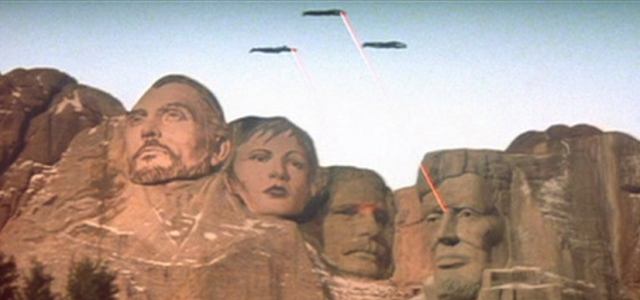
Body Count: 9
Number of Times Superman Smugly Lets a Villain Shoot Him in the Chest: 0 — though Zod smugly takes some.
Best Villain Dispatching: Though unsettlingly petty, I’d still probably have to give it to Clark’s revenge dispatching of the diner bully, shoving him all the way down the counter and into a pinball machine.
Superman’s Superest Feat: Erasing Lois’ mind with a single kiss is pretty impressive.
Best Use of His Brains: Tricking the villains into thinking that they’re stripping him of his powers by placing him inside a crystal booth, when in fact the booth is protecting Superman and stripping the powers of the three Kryptonians.
Should There Be a Sequel: Yeah, let’s keep going. We’ve still got Reeve and he’s the most important part.
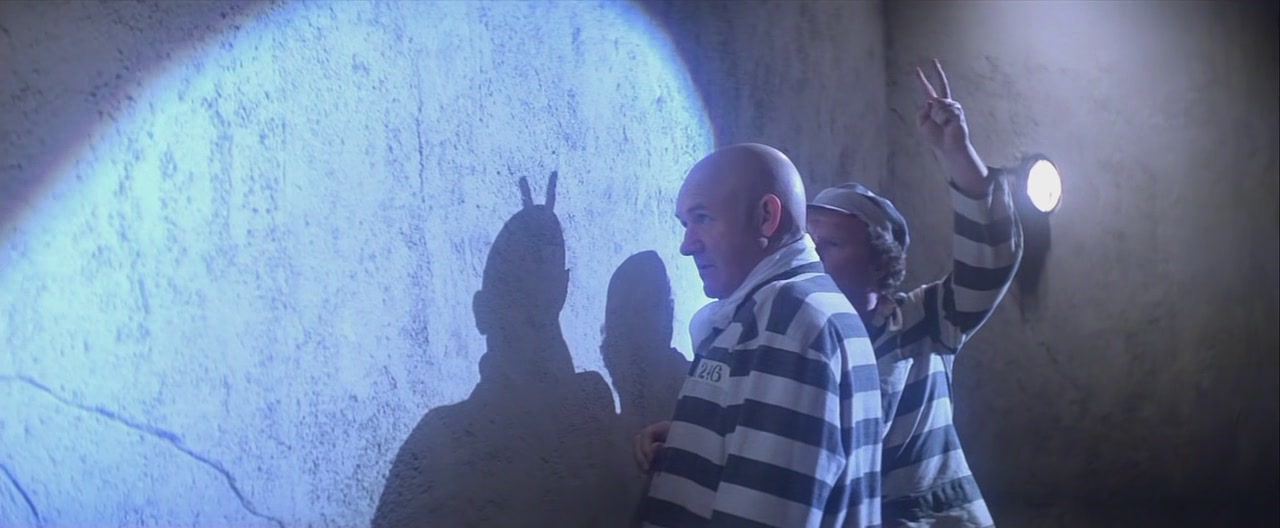
Up Next: Superman III
previous franchises battled
Alien
Back to the Future
Critters
Death Wish
Die Hard
Hellraiser
Home Alone
Jurassic Park
Lethal Weapon
Leprechaun
Meatballs
The Muppets
Phantasm
Planet of the Apes
Police Academy
Predator
Psycho
Rambo
Tremors